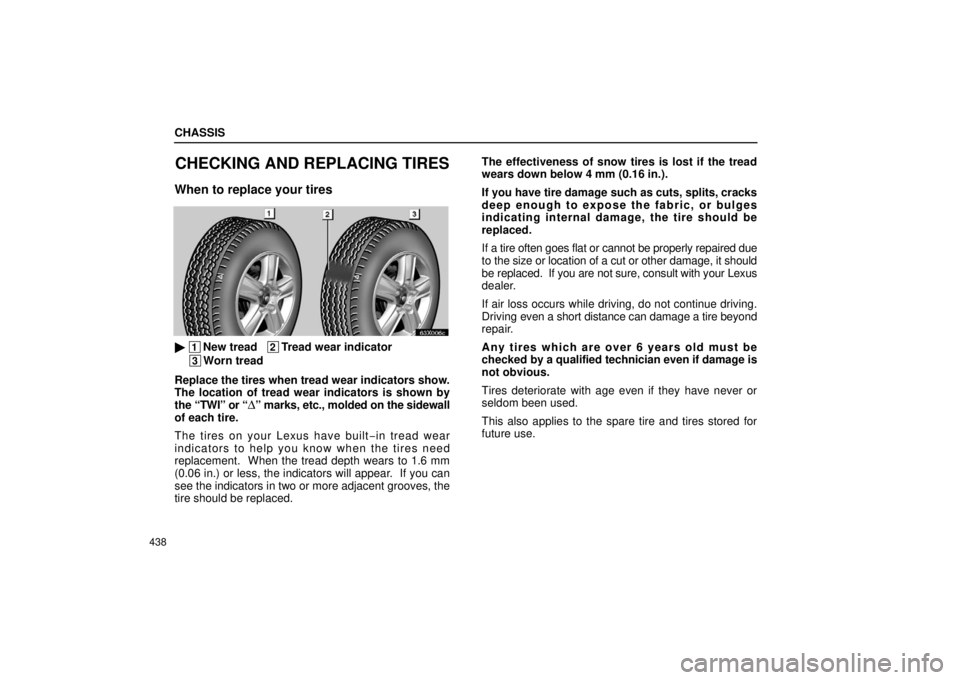Page 325 of 493

STARTING AND DRIVING
303
If the tire pressure warning light blinks...
31x609
If the tire pressure warning light blinks when the ignition
switch is turned to the “ON” position, the tire pressure
warning system is not working properly.
The system will be disabled in the following conditions:
(When the condition becomes normal, the system will work
properly.)
�
If tires not equipped with tire pressure warning valves and
transmitters are used.
� If the ID code on the tire pressure warning valves and
transmitters is not registered.
� If electronic devices or facilities using similar radio wave
frequencies are nearby.
� If a radio set at similar frequencies is in use in the vehicle. �
If a window tint that affects the radio wave signals is
installed.
� If the tire pressure warning select switch is set to a dif ferent
tire setting.
� If there is a lot of snow or ice on the vehicle, in particular
around the wheels or wheel housings.
� If non− genuine Lexus wheels are used.
� If tire chains are used.
� If the spare tire is in a location subject to poor radio wave
signal reception.
� If the tire inflation pressure is 500 kPa (5.1 kgf/cm2
or bar,
73 psi) or higher.
If the tire pressure warning light blinks frequently when the
ignition switch is turned to the “ON” position, have it checked
by your Lexus dealer.
Even if you use genuine wheels, the tire pressure warning
system may not work properly with some types of tires.
Pushing the tire pressure warning reset switch should not turn
off the tire pressure warning light.
Page 362 of 493

IN CASE OF AN EMERGENCY
340
�Stop the vehicle on a level firm ground, firmly
set the parking brake and put the transmission
in “P”. Block the wheel diagonally opposite to
the one being changed if necessary.
� Make sure to set the jack properly in the jack
point. Raising the vehicle with jack improperly
positioned will damage the vehicle or may allow
the vehicle to fall off the jack and cause
personal injury.
� Never get under the vehicle when the vehicle is
supported by the jack alone.
� Use the jack only for lifting your vehicle during
wheel changing.
� Do not raise the vehicle with someone in the
vehicle.
� When raising the vehicle, do not place any
objects on top of or underneath the jack.
� Raise the vehicle only high enough to remove
and change the tire.
NOTICE
Do not continue driving with a deflated tire.
Driving even a short distance can damage a tire
and wheel beyond repair.
40X002d
�On the left side of the luggage compartment
1Tool bag 2Jack
1. Get the tool, jack and spare tire.
To prepare yourself for an emergency, you should
familiarize yourself with the use of the jack and each tool,
and their storage locations.
When storing the jack, put it into place and secure to
prevent it from flying forward during a collision or sudden
braking.
Page 460 of 493

CHASSIS
438
CHECKING AND REPLACING TIRES
When to replace your tires
63X006c
� 1New tread 2Tread wear indicator
3Worn tread
Replace the tires when tread wear indicators show.
The location of tread wear indicators is shown by
the “TWI” or “
Δ” marks, etc., molded on the sidewall
of each tire.
The tires on your Lexus have built −in tread wear
indicators to help you know when the tires need
replacement. When the tread depth wears to 1.6 mm
(0.06 in.) or less, the indicators will appear. If you can
see the indicators in two or more adjacent grooves, the
tire should be replaced. The effectiveness of snow tires is lost if the tread
wears down below 4 mm (0.16 in.).
If you have tire damage such as cuts, splits, cracks
deep enough to expose the fabric, or bulges
indicating internal damage, the tire should be
replaced.
If a tire often goes flat or cannot be properly repaired due
to the size or location of a cut or other damage, it should
be replaced. If you are not sure, consult with your Lexus
dealer.
If air loss occurs while driving, do not continue driving.
Driving
even a short distance can damage a tire beyond
repair.
Any tires which are over 6 years old must be
checked by a qualified technician even if damage is
not obvious.
Tires deteriorate with age even if they have never or
seldom been used.
This also applies to the spare tire and tires stored for
future use.